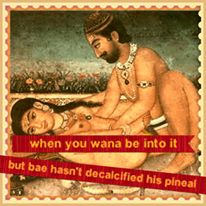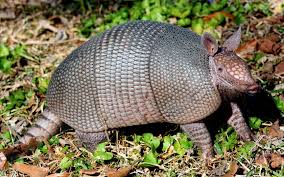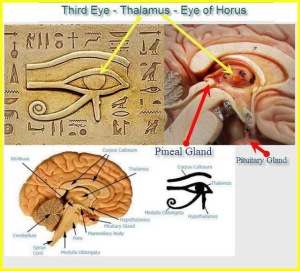“It’s not you…I just don’t think our pineal glands are in the same place right now.”#NewAgeDatingProblems
A while back, I was kinda bored and for reasons I still don’t fully understand, I made this meme. I thought it came out quite well.

I was just going to post this meme here, but then it got me thinking. Jokes aside, I find the idea of doing something like ‘de-calcifying your pineal gland’ quite fascinating. The concept is one of a panoply of New Age lifestyle/purificatory options, which rely at least in part on a veneer of scienc-i-ness for their legitimacy. A lot of angry people who understand real science have written a lot of furious think-pieces and status updates about how it’s impossible to ‘detox’ your body, how there’s no medical reason you NEED to steam your vagina or give yourself a coffee enema everyday, how all domesticated plants are technically Genetically Modified Organisms, how coconut oil, while good for some things, can’t cure everything, and how some things aren’t true just because a picture of turmeric online told you they were.

Recently, scholar of religion Alan Levinovitz shifted slightly from his interests in classical Chinese literature and ethics to write ‘The Gluten Lie’, a book about how popular dietary fads often boil down more to religious patterns of thought than actual nutrition science. People were making dire warnings about sugar and its disastrous effects on well-being long before diabetes existed, ideas about gluten-intolerance can be found in ancient Taoist texts about demonic parasites. A Tibetan friend of mine in Boulder once told me that his decision to ‘go gluten-free’ felt like he had joined ‘an elite, secret society’ – that statement alone should be sufficient to indicate how much dietary decision-making is inevitably about more than just what mush happens to be churning in your guts at any given moment. Anthropologist Mary Douglas famously laid out how categories of ‘purity’ and ‘pollution’ shape moral and dietary prescriptions, which in turn inform social hierarchies and patterns of social exclusion and belonging. Even when dietary prescriptions do accord with mainstream medical facts, they are necessarily about more than just calories or nutrients. Such prescriptions tie into our sense of ourselves and the world, what it means to be a ‘good’, ‘healthy’, ‘responsible’ person, are part of our class identities, our moral imaginations (Levinovitz deals with many of these points in this interview with The Atlantic).
So, what about ‘de-calcifying your pineal gland’? The WordPress spellchecker apparently thinks that ‘pineal’ isn’t a real word, but I assure you the teensy-weensy pineal gland exists in (most) people’s brains (although apparently it is possible to be born without one, which doesn’t seem like a fun time, and I recently learned too that at least some armadillos – as if these mouse-beetles were not weird enough already – also don’t have a distinct pineal gland)

(Not having even bothered to evolve a pineal gland to de-calcify, this nine-banded armadillo, the Richard Dawkins of the animal kingdom, doesn’t give a shit about your feeble human Spirit Science, or circadian rhythms)
RationalWiki has these very snarky things to say about pineal calcification/de-calcification:
“Other forms of pineal woo include the idea that the pineal gland has become “calcified,” through various nefarious agents, most notably fluoride, mercury from vaccines, even chemtrails.[7] [8] While calcification of the gland can actually happen[9], and does occur in roughly 50% of the population by age 12[10] why it happens isn’t clear. It’s claimed that clearing away your pineal calcification can do anything from enabling you to dream better, think more laterally, enable you to see “the truth” (read: believe in conspiracy theories), to activating psychic powers.[11] These beliefs are the basis for the Alt-Med crowd to push supplements and “detoxing” diets that supposedly will rid your pineal gland of the calcium that accumulates there.”
The possibility of the human pineal gland calcifying then, would seem to be medical consensus, but the causes, consequences, and well, appropriate way to respond to this fact continue to remain controversial. I had been seeing and hearing things about the need to de-calcify one’s pineal gland for a while, and was vaguely aware that pineal de-calcifying advocates tended to be associated with fluoride conspiracy theories. I had also seen this picture and variations of it pop up from time-to-time:

A couple of months ago, just prior to my making my amazing meme, it occurred to me to actually Google and find out what people were saying a person should, well like, actually do to de-calcify their pineals, aside from post information about the dangers of brain calcification on the webz. Here’s one pretty representative list of prescriptions from the site of one Metaphysics teacher S. Ali Myers, which claims to offer “the hottest esoteric, metaphysical, and spiritual news on the net!” (I thought that was this blog, actually, but fine – points for the Oxford comma at least!).
1. Eliminate or reduce meat intake (the rationale for this is to make one’s dietary choices more, uh, basic)
2. Drink alkaline or distilled water (similar basic vibes)
3. Avoid fluoride (connects to concern about fluoridized state supplied water)
4. Practice Sungazing (this need only be for a few minutes a day, when the sun is in the optimal position. Apparently the “pineal is a crystal and reacts remarkably to our Sun”)
5. Eat more greens & vegetables (This is tied back to alkaline diets and eating foods that have been ‘charged’ by sunlight)
6. Avoid mercury (this comes with the suggestion to swear off vaccines and anything but holistic dentists)
7. Maintain positive thoughts and actions (“This may seem a little elementary or not “deep enough” but, there is great power in your state of mind. Thoughts can also be toxic”, Myers tells us).
8. Take Blue Green Algae and other chlorophyll rich “superfoods” (This supplements the veggie intake)
9. Use herbs (this can be herbal teas, seasonings on salads, or herbals smoked during rituals)
10. Don’t use fluorescent bulbs (complete darkness is best)
11. Place a crystal on your brow chakra daily (This is as an adjunct to meditation practice – Myers favorites include amethyst, clear quartz, sodalite, and lapis lazuli)
You will notice that this list is quite general. The more sneering among you might even sum this all up and say, “So, the way to de-calcify your pineal gland is (uh, ‘basically’) just to be a hippie?” Myers’ advice is holistic – de-calcifying your pineal gland is more than just a once-off out-patient procedure. Rather, it is a commitment to a certain kind of life and broader consciousness, a way of being and moving through the world. Ann Vallely, in her excellent ethnographic research on Jain ethics, notes how despite their divergences, both ‘orthodox’ Jain renouncers in India and Jains in diaspora “stress the centrality of “nature” in the constitution of the moral self…For both, nature is the moral theater in which one’s ethical being is established – a fact that very well may be one of the most important features of Jain ethical life.”
We might say then, that ‘nature’ is also the moral theater in which de-calcifying New Agers establish their ethical selves – only in this case, nature is maybe less the bristling multi-layered animist multi-verse of Jain renouncers and more the ‘natural’ supplements section of Whole Foods. Whatever the case, I have no doubt that (some) of these recommendations will definitely improve individuals’ quality of life and potentially enhance their spiritual practice – I’ve done some of them myself! Whether they will actually de-calcify the tissue of one’s pineal gland is a different story.
What I find most interesting in all this is that the concept of something like pineal gland de-calcification hinges on a particular sort of blurring of levels or categories – a kind of literalization and materialization of esoteric concepts to which New Age and New Age-(y) (some winning social science theory here!) discourse seems to be especially prone. The current New Age mystique around the pineal gland is often traced back to Descartes, who aside from famously thinking he was and stuff, also proposed that the pineal gland was the seat in the body for the soul, and that it played a key role in ideation, memory, imagination and the movement of the body. The pineal was a kind of nexus point, a screen for impressions, and served as a link for Body-Soul/Subject-Object in Descartes’ now all too familiar world of Cartesian duality. Descartes of course, was an inheritor and modifier of existing wisdom about the pineal that far pre-dated him, as described here, on this Stanford site. The site offers a useful summary of some of Descartes’ thinking:
“The pineal gland played an important role in Descartes’ account because it was involved in sensation, imagination, memory and the causation of bodily movements. Unfortunately, however, some of Descartes’ basic anatomical and physiological assumptions were totally mistaken, not only by our standards, but also in light of what was already known in his time. It is important to keep this in mind, for otherwise his account cannot be understood. First, Descartes thought that the pineal gland is suspended in the middle of the ventricles (Figure 6). But it is not, as Galen had already pointed out (see above). Secondly, Descartes thought that the pineal gland is full of animal spirits, brought to it by many small arteries which surround it. But as Galen had already pointed out, the gland is surrounded by veins rather than arteries. Third, Descartes described these animal spirits as “a very fine wind, or rather a very lively and pure flame” (AT XI:129, CSM I:100) and as “a certain very fine air or wind” (AT XI:331, CSM I:330). He thought that they inflate the ventricles just like the sails of a ship are inflated by the wind. But as we have mentioned, a century earlier Massa had already discovered that the ventricles are filled with liquid rather than an air-like substance.
In Descartes’ description of the role of the pineal gland, the pattern in which the animal spirits flow from the pineal gland was the crucial notion. He explained perception as follows. The nerves are hollow tubes filled with animal spirits. They also contain certain small fibers or threads which stretch from one end to the other. These fibers connect the sense organs with certain small valves in the walls of the ventricles of the brain. When the sensory organs are stimulated, parts of them are set in motion. These parts then begin to pull on the small fibers in the nerves, with the result that the valves with which these fibers are connected are pulled open, some of the animal spirits in the pressurized ventricles of the brain escape, and (because nature abhors a vacuum) a low-pressure image of the sensory stimulus appears on the surface of the pineal gland. It is this image which then “causes sensory perception” of whiteness, tickling, pain, and so on. “It is not [the figures] imprinted on the external sense organs, or on the internal surface of the brain, which should be taken to be ideas—but only those which are traced in the spirits on the surface of the glandi H (where the seat of the imagination and the ‘common’ sense is located). That is to say, it is only the latter figures which should be taken to be the forms or images which the rational soul united to this machine will consider directly when it imagines some object or perceives it by the senses” (AT XI:176, CSM I:106). It is to be noted that the reference to the rational soul is a bit premature at this stage of Descartes’ story because he had announced that he would, to begin with, discuss only the functions of bodies without a soul.”
The pineal gland subsequently became associated with Theosophy-influenced ideas about chakras, and the ‘Third Eye’ or Ajna chakra in particular. More recently Dr Rick Strassman’s (speculative) comments about the connection between the pineal gland and the production of the endogenous super-turbo-extra-terrestrial-solve-all-mysteries psychoactive compound DMT in humans, has further contributed to the pineal gland’s blurry status as something both concrete and amenable to investigation and manipulation by means of materialist science, and as something that points to things altogether more transcendent, intangible, ‘spiritual’ or non-dual. Phil Hine has done some great research on the Theosophists and occultists that helped to promote the ‘medicalization’ or ‘materialization’ of Indo-Tibetan ideas about chakras. The idea that there is a set number of chakras that is specific to the human organism, and that these energy-centers correspond inherently and fixedly with specific parts of the endocrine and nervous systems is firmly established these days in New Age and occult contexts. As scholar of Hindu Tantra Christopher Wallis has shown, however, chakras as they exist within traditional Indian tantric sources are quite different to their New Age cousins. Not only is there no ‘authentic’ consistently arranged one system of chakras and subtle anatomy, but, crucially, many of the accounts of chakras as given in traditional texts are not descriptive at all but are given as part of a prescriptive process. As Christopher clarifies:
“English sources tend to present the chakra system as an existential fact, using descriptive language (like ‘the mūlādhāra chakra is at the base of the spine. it has four petals,’ and so on). But in most of the original Sanskrit sources, we are not being taught about the way things are, we are being given a specific yogic practice: we are to visualize a subtle object made of colored light, shaped like a lotus or a spinning wheel, at a specific point in the body, and then activate mantric syllables in it, for a specific purpose. When you understand this, point #1 above makes more sense. The texts are prescriptive — they tell what you ought to do to achieve a specific goal by mystical means. When the literal Sanskrit reads, in its elliptical fashion, ‘Four-petaled lotus at the base of the body’ we are supposed to understand ‘The yogī ought to visualize a four-petaled lotus…’”
This literalization and conflation of things like the ‘brow chakra’ as or with the pineal gland – and the pineal gland ‘as a crystal’ – seems to come from a desire to rationalize and standardize esoteric knowledge. I offered some reflections on these processes in my essay ‘My Mother was a Rock-Ogress Yeti Monster: True Tales of Dharma, Demons, and Darwin’, where I looked at a parallel case of rationalization/naturalization where a Tibetan indigenous rock-ogress cosmological demon was transformed into a kind of early primate zoological cryptid in an exile Tibetan children’s comic. I also discussed similar moves in post-Theosophical contexts as described by scholar Mikael Rothstein, where early mythologies of the Theosophical Mahatmas were (in some cases) rationalized and modernized for new, later audiences. As I said there:
“Rothstein uses the term [‘mythological modernization’] to describe how the Tibetan ‘Mahatmas’ or ‘Masters’, those super-beings that were supposed to be the higher powers behind Victorian esoteric movements like Theosophy, were later recast by new new religious movements as visitors from outer space. According to Rothstein, this move brought the ambiguously corporeal (and controversially located) Masters of a previous period up-to-speed with recent developments – it made them seem (relatively) less kitsch and (relatively) more tangible and reasonable too… This sort of mythological modernization has proven exceedingly popular more recently, as the likes of best-selling conspiracy theorist David Icke and the History Channel’s Ancient Aliens have reframed gods and spirits from the world’s pantheons as (maybe mostly probably) flesh-and-blood aliens to weave their alternative histories.”
I’m not sure I like ‘mythological modernization’ exactly for talking about the evolution of ideas about chakras and their manipulation, since it doesn’t quite capture Wallis’ important intervention about chakras’ ‘subtle’ nature in traditional tantric contexts. Chakras are not solely and wholly idiosyncratic inventions of individual meditators, produced afresh in each moment of practice, and yet they still are engaged with in practice through the medium of the individual’s creative imagination, in a prescriptive way. These points are not meant to imply that chakras in Indo-Tibetan sources have no connection at all to the body and its physical constituents.
In her wonderful recent book on home-grown Tibetan modernities and the relationships between empirical, medical knowledge and religious knowledge in the context of Tibetan traditional medicine, Janet Gyatso describes at length how Tibetan traditional doctors and yogic practitioners have grappled for centuries with the question of exactly how the subtle channels and chakras described in tantric yoga contexts exist in the average person’s body, and correlate with clinical knowledge about other vessels and channels, and the flow of bodily forces and fluids that is so important to medicine. Tibetan medical experts, as tantric yogis who had attained significant and often empirically demonstrable results from the manipulation of tantric subtle anatomy themselves, knew that the channels and chakras could not be entirely imputed fabrications, yet as doctors and professional investigators of the physical body, they knew too that elements of tantric subtle anatomy could not easily be ‘proven’ through things like autopsies. These doctors were also aware that they were inheritors of multiple, overlapping and seemingly divergent systems of subtle anatomy, and they came up with various creative and complex strategies to attempt to integrate tantric and medical systems, and to determine where and how the channels resided in the (typical) human body.
One can find many examples of literalization, or blurring of levels in esoteric contexts. I suspect this is in part a symptom of Cartesian dualist legacies and reactions to them. As we saw above, as Myers sheepishly admitted, “even thoughts can be toxic”, and if you have toxins just what are you gonna do about them? When instructions on breathing meditations are given the breath itself and the physical mechanics of air coming in and out of the lungs may be conflated with c’hi, rlung, prana, orgone – with the subtle vital-force, whatever THAT may actually be – that (maybe kind of?) ‘thing’ that ‘rides’ on the breath and which is being directed by focused attention and imagination. Or advocates of seminal retention for improving health and developing spiritual abilities may talk about physical semen and the more subtle concepts of vital-force and re-engagement with personal sexuality as if these are all wholly synonymous, and end up turning into veritable General Jack D. Rippers from Dr. Strangelove, gripped with constant paranoia about their ‘precious bodily fluids’ being compromised:
Scholars like Olav Hammer and Egil Asprem have traced very nicely how Western esoteric traditions have historically relied on appeals to esotericism and occultism as a kind of ‘secret science’ to legitimate their claims. I can appreciate such strategies and the historical conditions that have informed them. Still, I guess for me, my biggest gripe about today’s New Age naturalizations and materializations of things like the Third Eye as the pineal is probably this. Firstly, this sort of literalization ‘dumbs’ down what are actually sophisticated esoteric concepts involving rich intellectual histories and a great diversity of ‘native’ positions. Secondly, it gives the impression that esotericisms and spiritual disciplines are inherently superficial and un-critical, and are thus ‘low hanging fruit’ that snarky people who know real science can ignore or dismiss without needing to know anything about where these things come from (or about social science for that matter) . The irony is that this ‘scientizing’, which comes out of a desire for more credibility, for bringing esoteric concepts closer to authoritative, mainstream discourse, ends up doing those same concepts a disservice. Pseudo-scientific claims about esoteric concepts are easily ridiculed and debunked, and it’s then just as easy to feel like one has also dismissed the sheer existence and meaning, or possible alternative mechanisms of those concepts in the process.
Which, I dunno about you, seems like kind of a shame.

Pingback: “You Can’t Watch Pornos in the Monastery”: Tibetan Tantra, Imagined Pleasure, and the Virtuality of Desire | A Perfumed Skull
fluoride caclcifies the pineal–heart aorta and arteries !!!
LikeLike